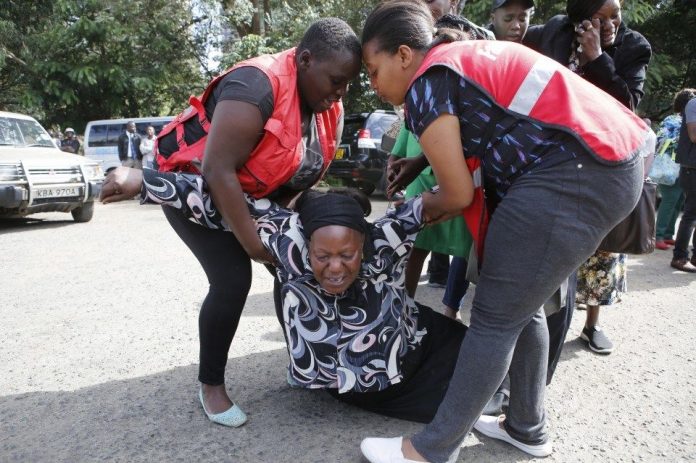In his State of the Union address, President Trump announced that the United States is conducting talks with the Taliban in Afghanistan to end the United States’ longest war, because “the hour has come to at least try for peace.” These talks reflect what scholarship has found: Most anti-insurgency wars end in conference rooms, not on battlefields.
However, the administration has not publicly applied that logic to another major counterinsurgency effort: Somalia. A January assault in Nairobi, leaving more than 20 dead, reminded the world that the Somalia-based Islamist militant group al-Shabab can still inflict terror inside and outside Somalia, despite more than a decade of internationally supported military campaigns to crush it.
Has the military approach reached its limits?
Guided by counterterror intervention strategies, the United States, Britain and the European Union have supported the multinational African Union Mission in Somalia (AMISOM) with funds and training and sought to build up the Somali national army as a counterinsurgent force. The United States has launched scores of drone strikes and armed raids against al-Shabab leaders and fighters. It has also deployed more than 500 troops to Somalia under the pretext of supporting regional stability.
Initially, AMISOM and the Somali army drove al-Shabab out of Somalia’s major cities and ports and into inland strongholds. But the war has been in a stalemate since then. The Somali army and its international partners have not been able to push al-Shabab farther back or stop the group’s assassinations and bombings, such as an October 2017 attack that left more than 500 civilians dead in Mogadishu.
To prevent al-Shabab from regaining territory, AMISOM needs more funding and troops. But international donors are tiring of the indefinite commitment and are planning troop reductions. Meanwhile, the Somali army is plagued with corruption and mismanagement, making it unlikely to be able to lead the fight against al-Shabab alone. Given these challenges and widespread fatigue among Somalis, the militarized approach appears unlikely to bring a decisive victory or a conclusive peace.
Our research shows that counterterror may be counterproductive
For the past two years, we have worked with the international peace-building organization Saferworld to research constructive alternatives to the counterterror approach in Somalia. This entailed more than 300 interviews with community members, politicians and elders from government- and al-Shabab-held areas. We also conducted an extensive literature review involving countries around the world that have, since the 1990s, concluded civil wars against insurgent movements.
Policymakers and local communities we talked to throughout Somalia increasingly feel that military counterterror operations are not moving Somalia toward a durable peace. AMISOM and the Somali army measure success by metrics such as how many al-Shabab leaders and fighters they kill and how much territory the group occupies. But death and acreage are poor measures of peace and stability. Nor does the military effort provide an effective response to the poverty, corrupt and dysfunctional government, collapsed justice institutions, and displacement that enable al-Shabab to retain support and act as a shadow government in the areas it controls.
Many of the people we interviewed said that military attacks on al-Shabab have actually made life worse, especially in areas under the group’s control. When it perceives a military threat of elimination, al-Shabab ramps up its efforts to control territory and populations, protect against infiltrators and spies, and generate revenue for its war effort. That leads to heightened paranoia, distrust, oppression, punishment and harsh taxation in al-Shabab territory.
While AMISOM, the Somali army and U.S. airstrikes have killed many top al-Shabab leaders, they are regularly replaced by successors who are even more determined to launch high-profile attacks against the government and civilians. Civilian deaths during botched military operations by the Somali army and international allies exacerbate popular grievances over inadequate judicial and security services and sexual abuse and looting by military forces. Those grievances, according to the U.N. Development Program and other researchers, drive recruits to extremist groups such as al-Shabab.
Is it time to consider negotiated alternatives?
If counterterror action fails, how can conflicts against insurgencies end? According to research by political scientist Seth Jones and Rand researcher Martin Libicki, dialogue and political agreements are more likely to end these conflicts than military victory by either side. This was true in the peace processes that ended Northern Ireland’s 30-year “Troubles” in 1998, the 40-year conflict between the Moro Islamic Liberation Front and the government of the Philippines in 2012 and the 52-year conflict between the Revolutionary Armed Forces of Colombia, or FARC, and the Colombian government in 2016. Talking, not fighting, ended these wars.
Has the time come to discuss whether exploring dialogue with al-Shabab could succeed where the drones and bombs have not? The group’s attacks on civilians and its allegiance to al-Qaeda have made it a notorious pariah and an unpalatable negotiating partner. But we found that Somali policymakers and ordinary people have stopped believing that military victory is possible and have a strong appetite for negotiation. In one limited sample of 70 Somalis we interviewed in government- and al-Shabab-controlled areas, 70 percent indicated that they would support dialogue to end the conflict. Meanwhile, political scientists Mahdi Abdile and Anneli Botha have found that although al-Shabab’s leadership has not clearly signaled interest in negotiating, some commanders are open to the idea.
The historical cases we studied indicate that years of patient negotiation and multiple rounds of failed agreements can be expected. Some Somalis and international actors with whom we spoke feared that peace could mean that al-Shabab members will not be held responsible for crimes against civilians. But other countries torn apart by conflict have used transitional justice and reconciliation methods to move toward peace, including in Rwanda and South Africa. Politicians may hesitate, fearing failure, but comparative research suggests that even failed peace processes can reduce overall violence.
By By Peter Mackenzie
Joanne Crouch is research team leader for Saferworld Somalia. Peter Mackenzie is the former country director for Saferworld Somalia.
Read more:





























